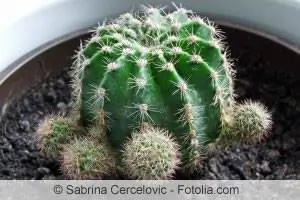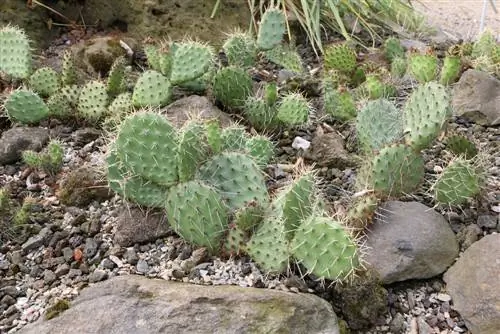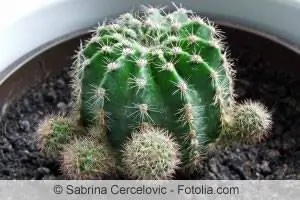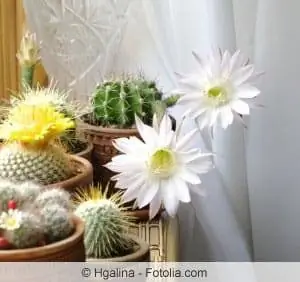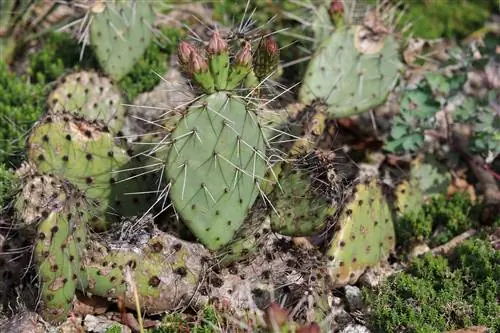- Author admin [email protected].
- Public 2023-12-17 03:39.
- Last modified 2025-06-01 06:48.
Cacti and succulents are very undemanding plants, which influences the choice of substrate. Mineral and humus-poor soils are preferred, but there are many possible variations in their composition. Mineral substrates can also be mixed yourself to create an optimal breeding ground for the cacti and succulents in which they can develop well.
Cacti and succulents are the plants that can bring a lot of joy even to people without a green thumb. Anyone who has already taken a closer look at cacti will quickly notice that they already colonize the most impassable and infertile areas in their countries of origin. In this country, cacti and succulents have similarly low demands and also require soil that is not very nutrient-rich. The ideal substrate for cacti therefore consists largely of mineral components. However, there are many options for variation when selecting the individual mineral components, which means that individual substrates can be mixed for cacti and succulents.
Cactus substrates - less is more
There are around 1,800 different types of cacti worldwide, plus several thousand different types of succulents. Despite the different species, there is one thing these plants have in common - their preference for locations that are characterized by poor nutrient-rich soil. The substrate should also be structured accordingly, which should be slightly acidic for most cacti. A pH value between 5.5 and a maximum of 7 would be optimal. It is important for the substrate to have high air and water permeability. As in nature, where cacti and succulents grow on stony and gravelly soil, there is no waterlogging and excess nutrients can flow away. This is also important for growing in pots, as the cacti and succulents store immediately after fertilization, which is usually in liquid form, and excess nutrients would then lead to over-fertilization.
Unsuitable substrates
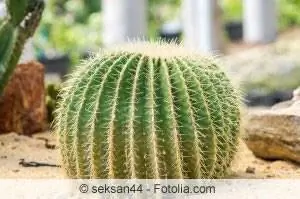
Commercial potting soil is completely unsuitable for cacti and succulents, as it can lead to strong growth, but can also lead to rot. In addition, the substrate should not exceed a pH value of seven, otherwise the soil will be too acidic, which will kill the cacti in the long term. If you are not sure what pH value the soil has, you can get a test set from the pharmacy and determine the pH value yourself. Not every mineral is suitable for cacti and under no circumstances should building sand be used. This contains too much lime and can lead to what is known as chlorosis. This inhibits the formation of chlorophyll, which in the long term leads to the death of cacti and succulents.
Tip:
The substrate should be adjusted in terms of lime content if the irrigation water is very calcareous. Here you should generally pay attention to a substrate with less lime, as the cacti are supplied with lime via the irrigation water.
Aggregates
The list of possible substrates is long, because although all cacti and succulents prefer mineral and nutrient-poor substrates, domestic succulent species, for example, can tolerate a higher proportion of humus than, for example, succulents from Mexico.
Lavagrus
Lavagrus is a volcanic material that should have a grain size of between three and seven millimeters. It has the property that it can store large amounts of water, which is then gradually released back to the plants.
Pumice gravel
Pumice gravel is also of volcanic origin and has a slightly acidic pH value. Only fine gravel components of pumice gravel should be used, as fine sand or dust could compact the substrate unnecessarily.
Urgesteinsgrus
Ursteinsgrus consists of granite or gneiss and is slightly acidic. The advantage is that this material has a high proportion of nutrients such as potassium or iron, which are gradually released from the rock and supplied to the cacti and succulents.
Expanded Slate
Blähschierer is ideal for creating drainage at the bottom of the pot. It also ensures stability and at the same time ensures good air and water permeability.
Quartz sand/quartz gravel
Quartz sand or quartz gravel is used to loosen the substrate and can also be used to cover the surface.
Diatomaceous earth
Diatomaceous earth has a pH value of around 5.5 and gradually releases important nutrients for the cacti and succulents. It can also bind moisture very well, which prevents mold from forming.
In addition to these additives, there are other additives such as clay, perlite and much more that are added to the substrate. When selecting the additives, it is important that the materials used are those that are also found in the homeland of cacti and succulents.
Optimal mix
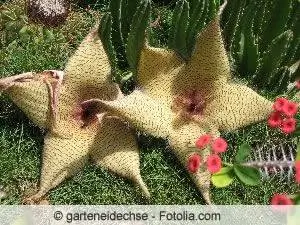
If you have little experience with cacti, you can take ready-made soil from a specialist store and mix it with additives. However, the proportion of cactus soil should not be more than 75% and the remaining 25% can be filled with pumice gravel, for example, which can also store nutrients well. If you already have experience with growing cacti, you can mix the entire substrate yourself, which can, for example, contain a small proportion of humus that is at least three years old. However, for sowing cacti and succulents, the proportion of humus should be slightly larger and take up around 1/3. The rest consists of finely sieved mineral substrate that is mixed with the humus.
Tip:
The substrate of cacti and succulents that come from wholesalers is often not suitable for the plants in the long term. Therefore, the plants should be quickly repotted with a freshly mixed substrate so that, for example, waterlogging or subsequent rotting roots do not occur.
Frequently asked questions
How is the substrate treated before sowing?
Before using the mineral substrate, it is moistened well and sterilized in the oven for 30 minutes at around 150 °C. This kills fungal spores, for example, which can damage the plants. Sterilized soil is particularly important when sowing, as otherwise foreign seeds could germinate and unnecessarily take away nutrients from the cacti and succulents.
Clay or plastic pot?
Opinions differ here in any case, because both have advantages and disadvantages. Clay pots promote faster evaporation, but they can break quickly and are expensive. Plastic pots are more stable and cheaper, but require better drainage as evaporation is much slower.

